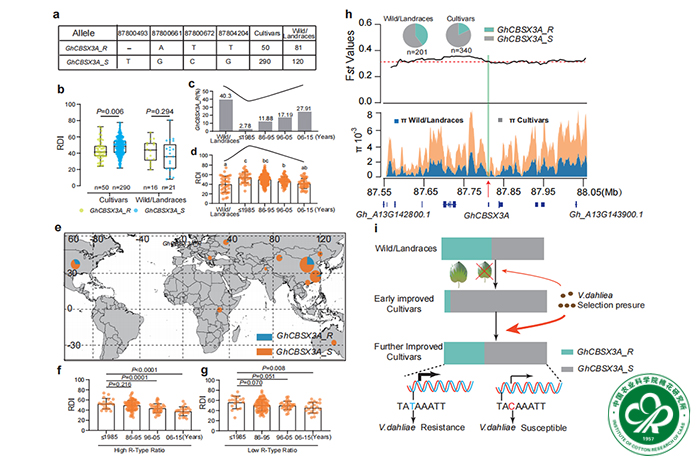- Location : Home» Newsroom
Promotion of apoplastic oxidative burst by artificially selected GhCBSX3A enhances Verticillium dahliae resistance in upland cotton
Recently, the team led by Li Fuguang at the Cotton Research Institute of the Chinese Academy of Agricultural Sciences discovered that during the domestication and improvement of upland cotton, key disease resistance genes were artificially selected to meet the breeding requirements of different periods. Moreover, they clarified the resistance mechanism mediated by the outbreak of foreign plasmid reactive oxygen species in this disease resistance pathway, providing an important target for the genetic improvement of cotton disease resistance. The relevant research results, titled "Promotion of apoplastic oxidative burst by artificially selected GhCBSX3A enhances Verticillium dahliae resistance in upland cotton," were published in The Plant Journal, a top journal in Biology Region 1.
Verticillium wilt (VW) is a devasting disease affecting various plants, including upland cotton, a crucial fiber crop. Despite its impact, the genetic basis underlying cotton's susceptibility or defense against VW remains unclear. Here, we conducted a genome-wide association study on VW phenotyping in upland cotton and identified a locus on A13 that is significantly associated with VW resistance. We then identified a cystathionine β-synthase domain gene at A13 locus, GhCBSX3A , which was induced by Verticillium dahliae . Functional analysis, including expression silencing in cotton and overexpression in Arabidopsis thaliana , confirmed that GhCBSX3A is a causal gene at the A13 locus, enhancing SAR-RBOHs-mediated apoplastic oxidative burst. We found allelic variation on the TATA-box of GhCBSX3A promoter attenuated its expression in upland cotton, thereby weakening VW resistance. Interestingly, we discovered that altered artificial selection of GhCBSX3A_R (an elite allele for VW) under different VW pressures during domestication and other improved processes allows specific human needs to be met. Our findings underscore the importance of GhCBSX3A in response to VW, and we propose a model for defense-associated genes being selected depending on the pathogen's pressure. The identified locus and gene serve as promising targets for VW resistance enhancement in cotton through genetic engineering.
This work was supported by funding from the Key Research and Development Project of Henan Province (231111110400), the National Key Research and Development Program (2021YFF1000102-1), Natural Science Foundation of Henan (No. 232300421010), Central Public-interest Scientific Institution Basal Research Fund (No. Y2023XK16), Innovation Program of the Chinese Academy of Agricultural Sciences (CAASASTIP-IVFCAAS), the Fundamental Research Funds of State Key Laboratory of Cotton Biology (CB2021E03), and Innovation Program of Chinese Academy of Agricultural Sciences (CAAS-CSIAF-202302). We would like to thank Prof. Xiaoyang Ge and Prof. Hang Zhao for their constructive comments. We thank Dr. Savannah Grace at the University of Florida for her assistance with the English language and grammatical editing of the manuscript.
https://doi.org/10.1111/tpj.16736
